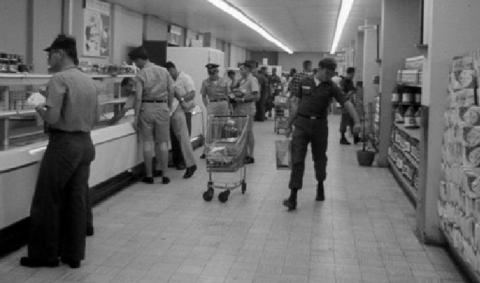Commissaries in Vietnam: During the war, U.S. stores served troops, families, contractors, government civilians, reporters

Note: See video on DeCA’s YouTube page related to U.S. commissaries in Vietnam.
FORT LEE, Va. – In observance of National Vietnam War Veterans Day, March 29, the Defense Commissary Agency reflects on the service and sacrifice of these veterans and their families, and remembers the commissaries that served them.
By the spring of 1965, when the first wave of U.S. combat troops – 3,500 Marines – came ashore at Da Nang, South Vietnam, a number of American military advisors, including some with accompanying family members had already been stationed in Vietnam for nearly a decade. The Americans had replaced French military personnel who had unsuccessfully attempted to regain control of their Indo-China colony after World War II.
Several years before the Marines arrived, the first American military commissary had opened in Saigon in 1959 and was operated by the U.S. Navy. Branch commissaries subsequently opened in Long Binh, Cholon and Newport districts, and near Tan Son Nhut Air Base.
Americans living in base housing in the late 1950s and early 1960s recalled how the commissaries in Vietnam carried all of the top brand name foods they had become accustomed to in the States. Service members and their family members lived in American housing communities and the children attended Department of Defense schools in the housing areas. The servicemen’s wives especially appreciated that they carried American brand name cereals and baby foods that their children enjoyed.
A military retiree remembered that the commissary store in Saigon was one of the largest and most modern commissaries he’d ever shopped in. They not only carried hundreds of brand names but also had a full service deli and bakery in the store. He joked that it had everything a soldier needed “except a ticket back to the U.S.”
The commissaries served American service personnel and their families as well as U.S. news reporters, government civilians and contract workers stationed in Vietnam. However, commissary patronage in Vietnam significantly changed in early August 1964, following the Gulf of Tonkin incident, where two reported attacks by North Vietnamese forces on American Navy vessels, eventually led to the start of the United States’ combat operations. The expansion of hostilities caused all U.S. dependents to be evacuated immediately from Vietnam.
At first, the Saigon Commissary could not accommodate the thousands of incoming combat troops scattered all over Vietnam. So those troops were given mess hall privileges and pay bonuses in their pay to enable them to shop on the local economy.
As the war expanded so did the availability of products in commissaries. In 1965 a U.S. dairy company opened operations in Saigon and started shipping dairy products to the commissaries all over Vietnam. The company received whole milk solids from the States, which were then reconstituted with purified water and packaged in cartons for distribution. Some former service men recalled that the chocolate milk was outstanding.
In the spring of 1966 the U.S. Army took over running the commissaries. These stores remained in operation even after the 1973 cease-fire because many U.S. service personnel were still stationed there in non-combat missions.
On April 30, 1975, communist forces overran Saigon, and American contractors and Vietnamese support personnel had to flee for the airports in a frantic effort to evacuate. In the aftermath, the local population looted the abandoned American commissaries and took as much food as they could carry.
It was a sudden and unceremonious end to the American commissaries in Vietnam.
